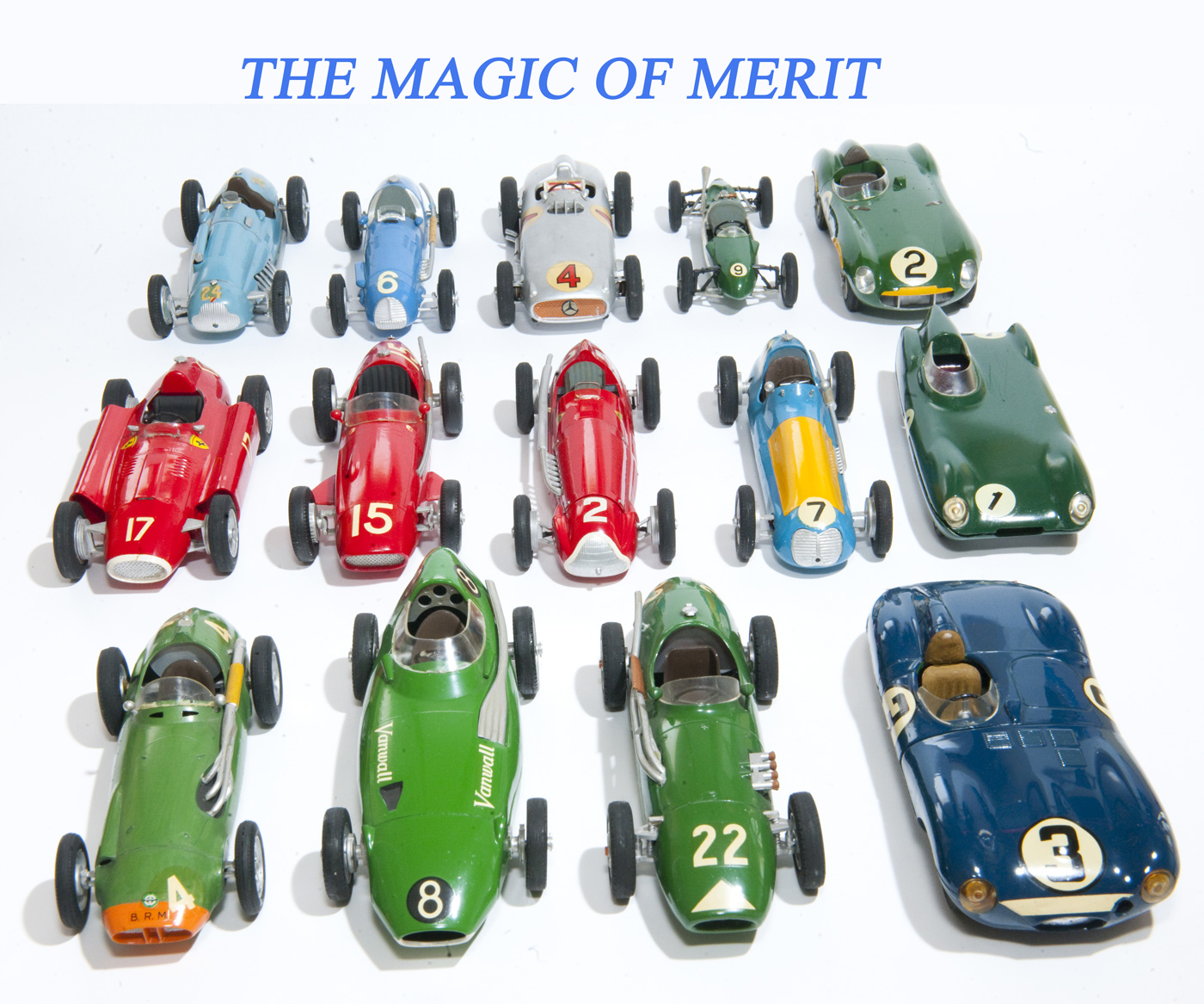
The whole range of the Merit 1:24-scale plastic kit assembled and painted in period: mid-Fifties. Front line: British F1 and the Jaguar D-Type. Mid row: Italian F1 and Grand Prix racers and the Lotus 11. Rear row: French racers, Mercedes W196, Cooper 500 MkIX and Aston Martin DB3S.
Text, photos and models by Aldo Zana
It was hard times in the second half of the Fifties for European kids in love with Formula One and longing to become part of its world by collecting and playing with model racers.
We Italians faced especially limited choices: the hard-to-find die-cast Nigam, the elusive Zax, or the old Mercury racers of the Forties: oddly scaled, with questionable faithfulness and tires fit for an all-terrain army truck. The rise of globalization brought from the UK to the best Italian toy shops the die-cast Dinky Toys and the first Corgi Toys. The former listed obsolete F1/F2 single seaters of the early Fifties in its catalog. Corgi featured more updated models of British production: however, merely two, already uncompetitive in real life against our all-conquering Ferraris and Maseratis after Mercedes’ withdrawal in 1955. And they looked too small alongside the Dinkies and Mercuries.
And then, out of the blue, Merit, although quite difficult to locate amoung the contemporary fast-growing and highly visible offerings of plastic (polystyrene) kits dominated by the leading US brands of Monogram, Revell, and Aurora.
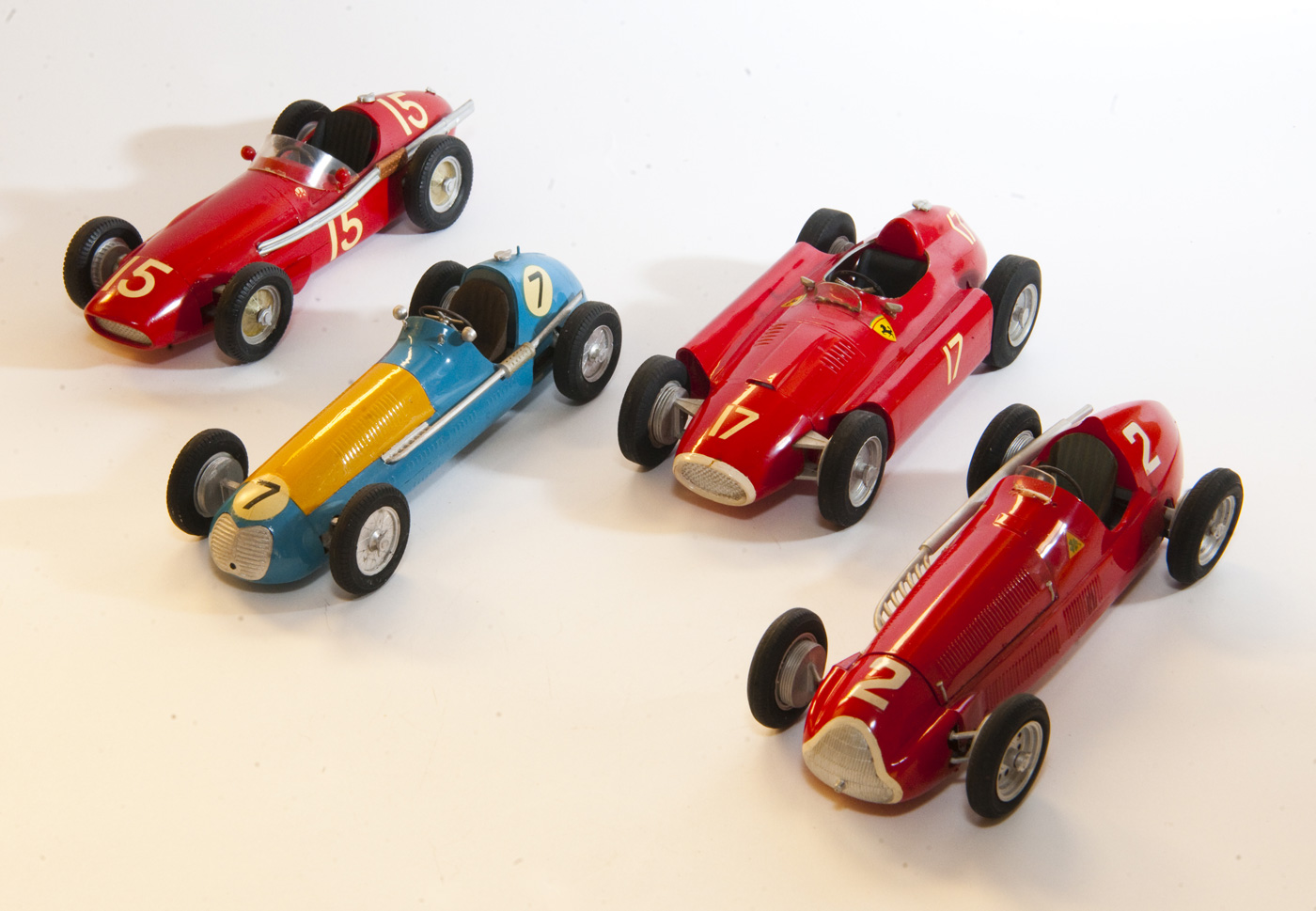
Italian racers of the Forties and Fifties. From the left: Maserati 250F, Maserati 4CLT/48, Lancia Ferrari, Alfa Romeo 158.
In 1957 Merit produced precise 1:24-scale models of current F1 protagonists: Lancia-Ferrari V8, Maserati 250F, Gordini T-16, as well as milestones of the pre-1952 F1 seasons: Alfa Romeo 158, Talbot-Lago T26, Maserati 4CLT/48 “San Remo”. And thanks to a flurry of new offers in a few months’ span, we could also buy and build the emerging British single-seaters striving for the limelight after a decade of playing second fiddle to the Italians in the form of the Connaught B-Type “Syracuse” 1956, BRM P25 1956, and Vanwall VW4 1956.
It became easier for Italian kids to become loyal to Merit’s growing offer of racing cars. The company enlarged its range with three sports car icons, all made in the UK: the well-known multiple winner Jaguar D-Type, the lesser known Aston Martin DB3S and the yet unknown Lotus Mk XI, a name on the verge of becoming a leader.
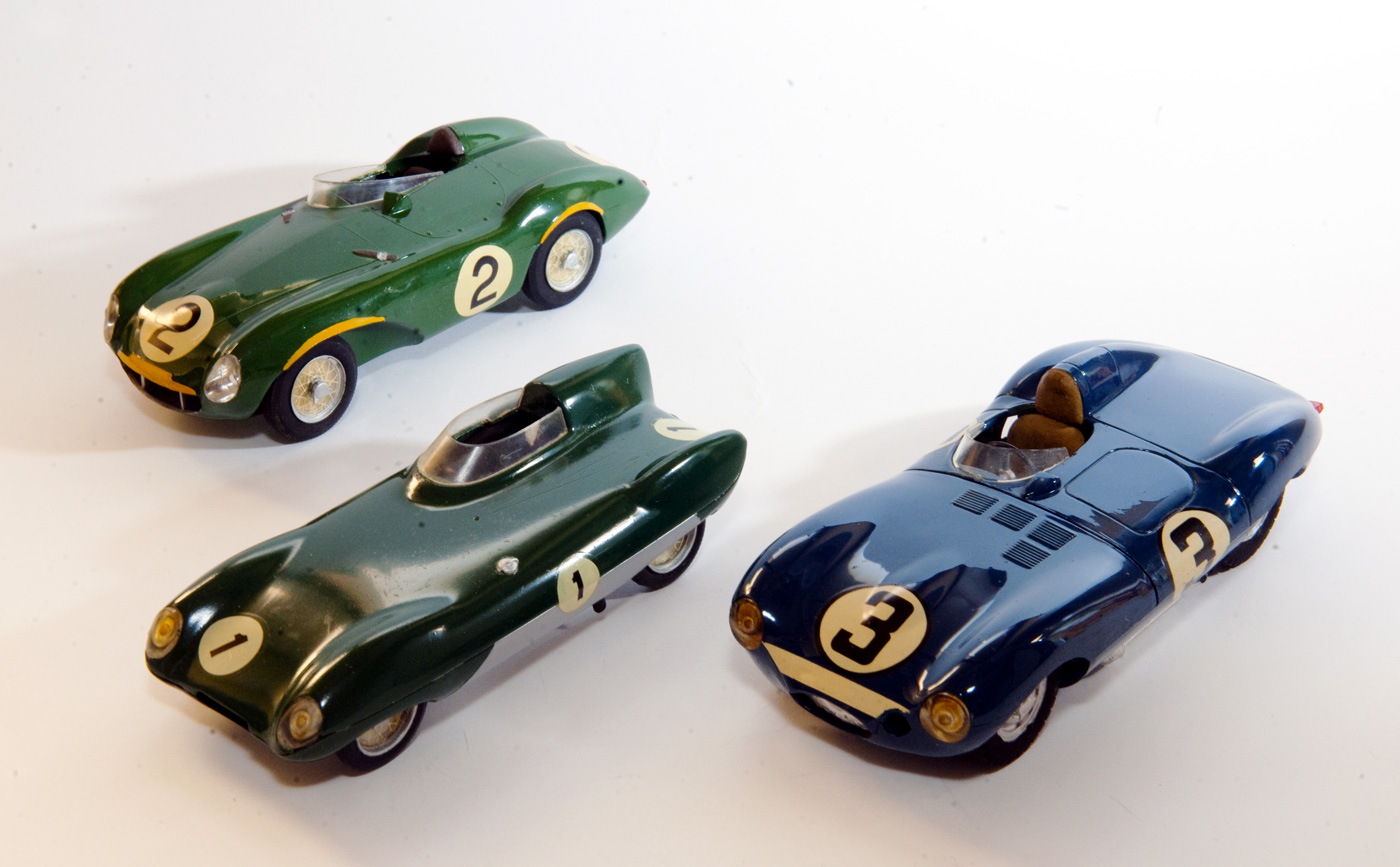
All British the three sports cars in the series. From the left: Aston Martin DB3S, Lotus 11, Jaguar D in Ecurie Ecosse livery.
The Merit kits came from a company called J & L Randall Ltd., based in the town of Potters Bar, Hertfordshire, north of London. They were all sold in a standard, non-descript box, the same for every model: small and unappealing at a time when competing US brands already showcased their products on box-lids with colorful and attractive art to win the prime spots in shop windows. The only way to select the right Merit kit was a small label glued on one of the narrower sides.
They were quite expensive for the period, too: 1,100 Liras, when the average monthly salary of a worker was about 45,000 Liras. By comparison, a Mercury die-cast model racer cost 180 Liras and a Dinky 230-250 Liras.
The kits were molded in flawless plastic; the surface was so clean and regular that it was possible to skip painting the body. It wasn’t a simple task for a kid to smoothly brush the Humbrol enamels; airbrushes for modelers were still a long way into the future. The solvent used at that time by Humbrol allowed, nevertheless, a clean and uniform finish even when working with the brush.
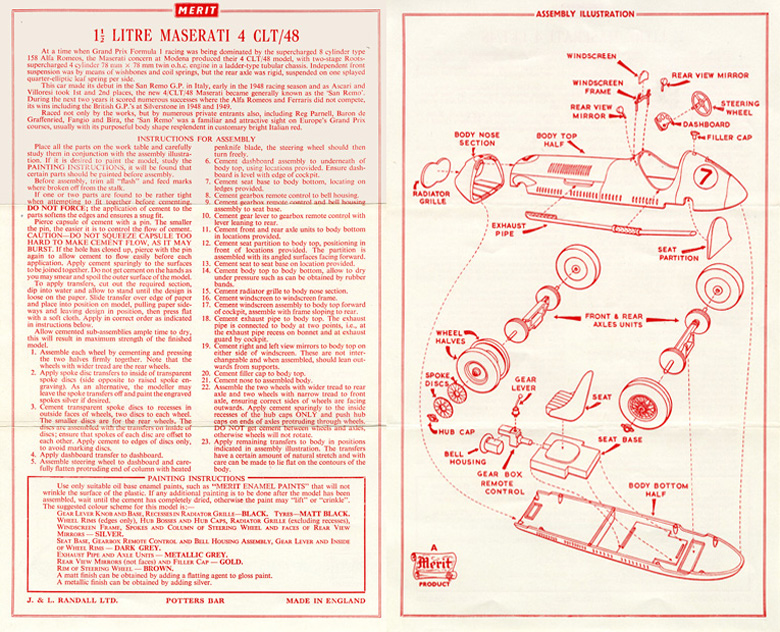
The instruction sheet of the 4CLT/48 Maserati. The front side tells in short the history and the races of the real car, the back side presents a clear illustration of the easy assembly procedure.
Assembly was quite straightforward too: the body was split in two halves, top and bottom. Axles and driver seat had to be glued to the bottom half, other details (exhaust pipes, windscreen, dashboard, steering wheel) to the top section, before joining these two subassemblies. Each wheel/tire was molded in two halves and the tire had to be carefully painted matte black. The spokes were a decal (transfer, in British parlance) to be applied on a little transparent celluloid disc, subsequently set onto the outside of the wheel prior to gluing the hub cap. The quality of the decals was only fair and I preferred to avoid them.
The racing number decals were usually quite hard and dry, prone to cracking. Yet, it was possible to soften them using highly diluted vinyl glue, given the lack of softening liquids on the market. The instruction sheet had a pedantic list of building steps on the front, ending with the painting indications, but a clear assembly drawing on the back. More interesting was, at the top of the first page, a short presentation of the real car, a resumè of its main successes as well as a basic description of its technical characteristics and performance.
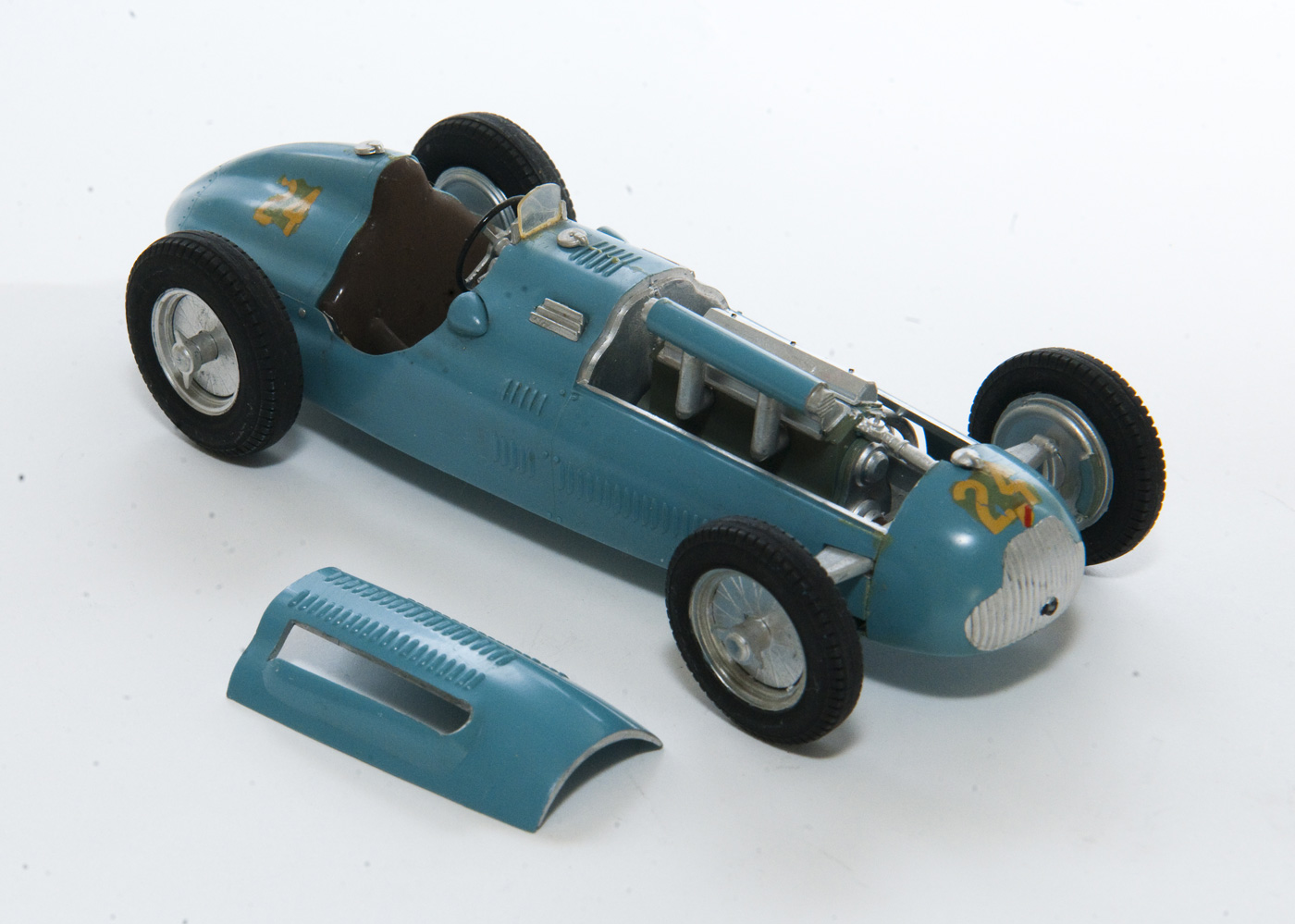
Talbot-Lago T26, 1949, one of the two “super” kits featuring engine detail. The body was left unpainted. Note the smoothness of the plastic injection.
Two kits were super-detailed to include the engine and the removable engine bay cover: the 1950 Alfa Romeo 158 and the 1949 Talbot-Lago T-26 4.5 liter. Both were probably made so detailed because the molds were already available when the pressure to launch the new models forced the company to simplify and shorten the production cycle. The whole range of the 1956 F1 and Sports cars went on sale within 1957, in a remarkably short time to market: Lancia-Ferrari, Maserati 250F, BRM P25, Connaught B-Type “Syracuse”, Gordini T16, Vanwall VW4.
Very British was the addition of the Cooper 500 Mk IX, 1956. A tribute to the former German dominance was the kit of the Mercedes W196, the 1954 road-racing version mistakenly presented as the 1955 model. The Maserati 4CLT/48 was another obsolete racer in the series. The kit didn’t have the inner details of the Alfa Romeo and the Talbot-Lago. It was an unusual selection of a car that wasn’t a winner, yet it was driven by Thailand’s Prince Bira and Brit Reg Parnell.
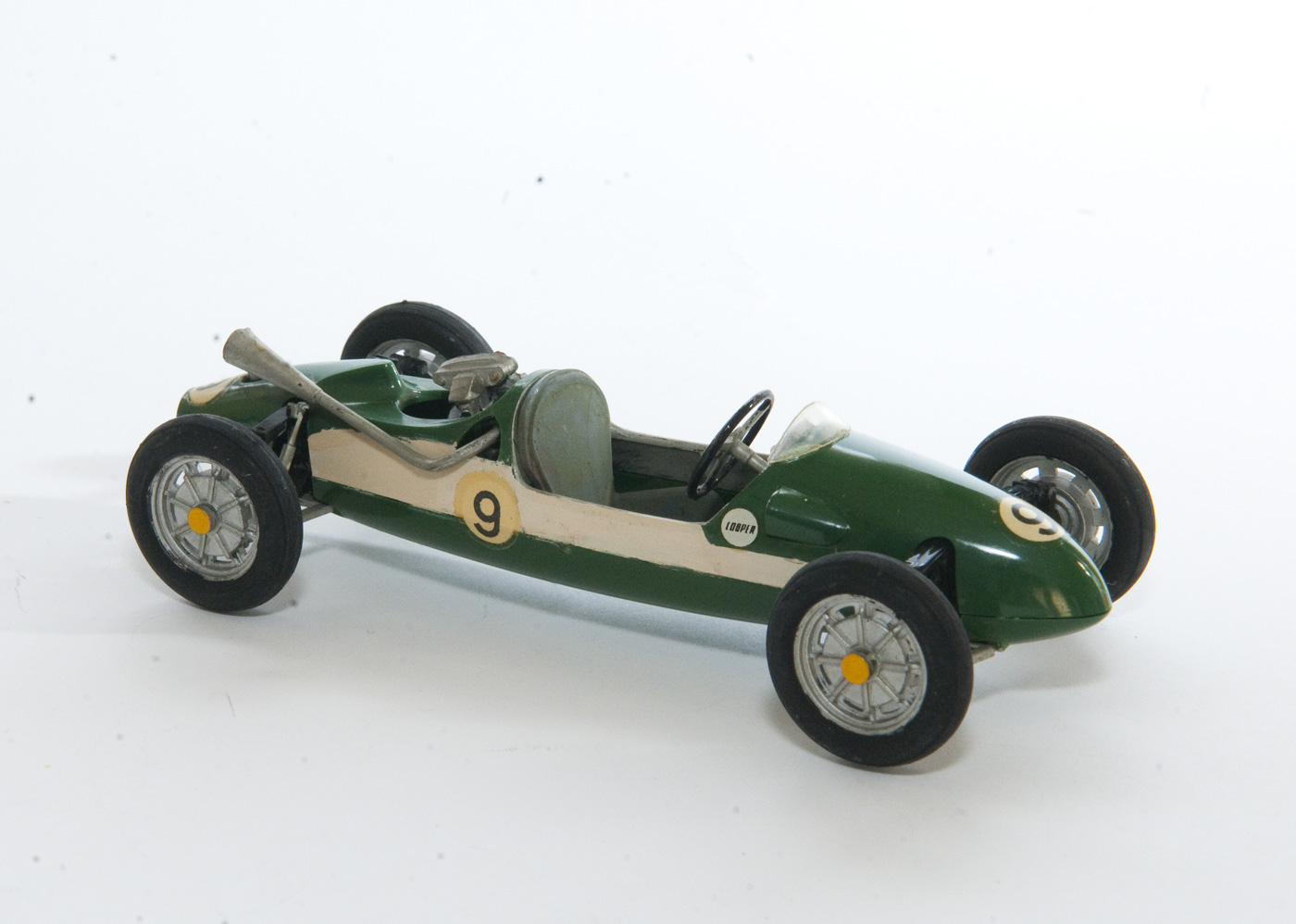
A real piece of history outside F1 and sports cars, the Cooper 500 Mk IX, 1956, recalls a glorious period of British racing. Body unpainted.
A final touch of class was the color of the ink used for the instruction sheets: dark red for the Italians, British Racing Green for the British, blue for the French. The Mercedes sheet fell outside the paradigm, printed in dark blue as the historically correct white or silver would have been impossible to read.
The boxes of the more recent kits contained a small multi-page educational leaflet on Motor Racing, a more detailed description of the prototype, and a promotional bottom line advertising the brand of motor oil used in races by the car. The leaflet on the Vanwall doubled to eight the pages and ended with a tribute to Tony Vanderwell who “raised the prestige of British Automobile Engineering throughout the world”.
Britain still ruled. And the following year it also became true in F1.
Below, all fourteen of the Merit models in individual photos. You won’t see this often!
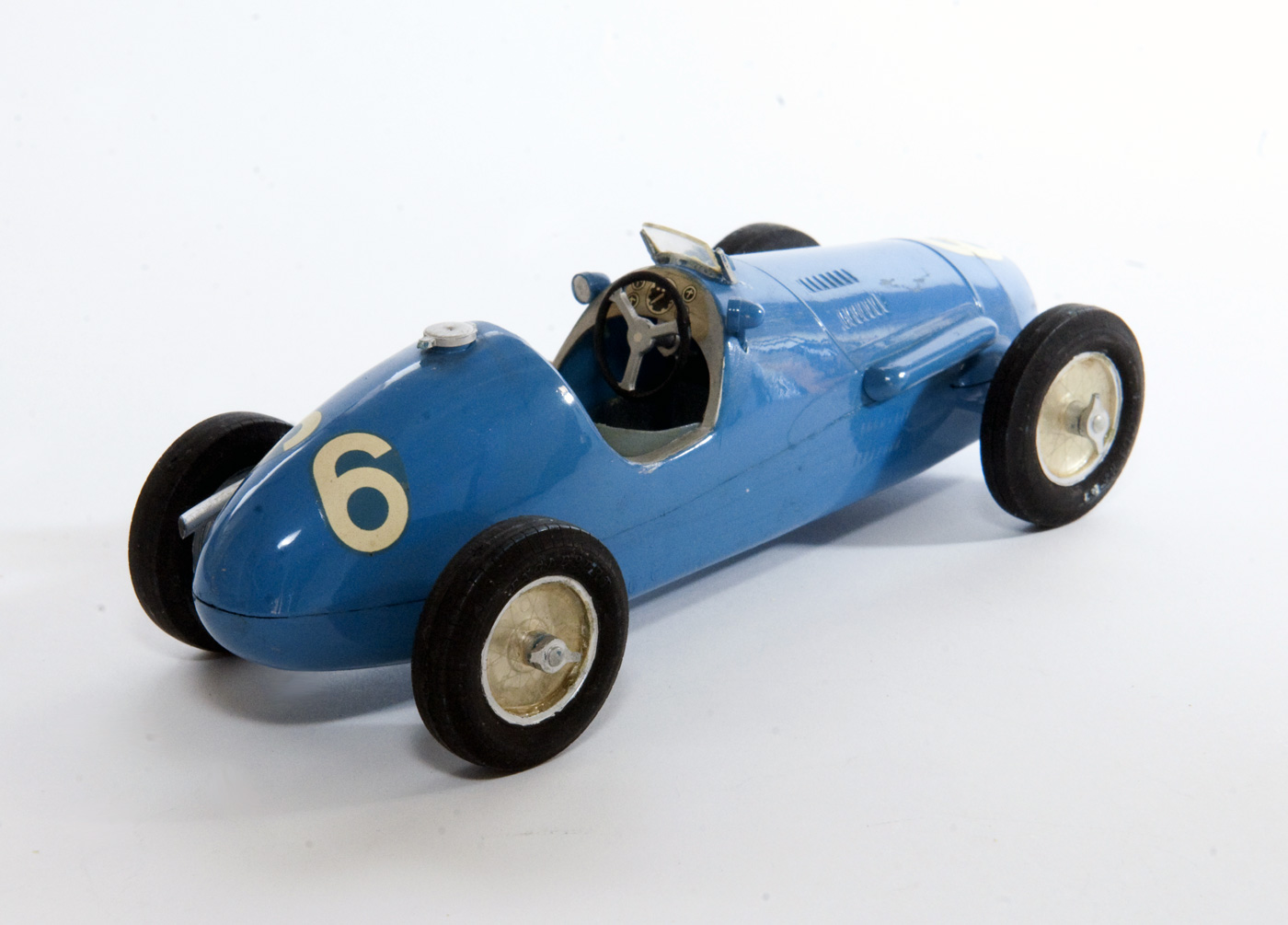
Gordini six-cylinder F2, 1952. Humbrol paint (“Enamel” on the original British tin) to cover the body.
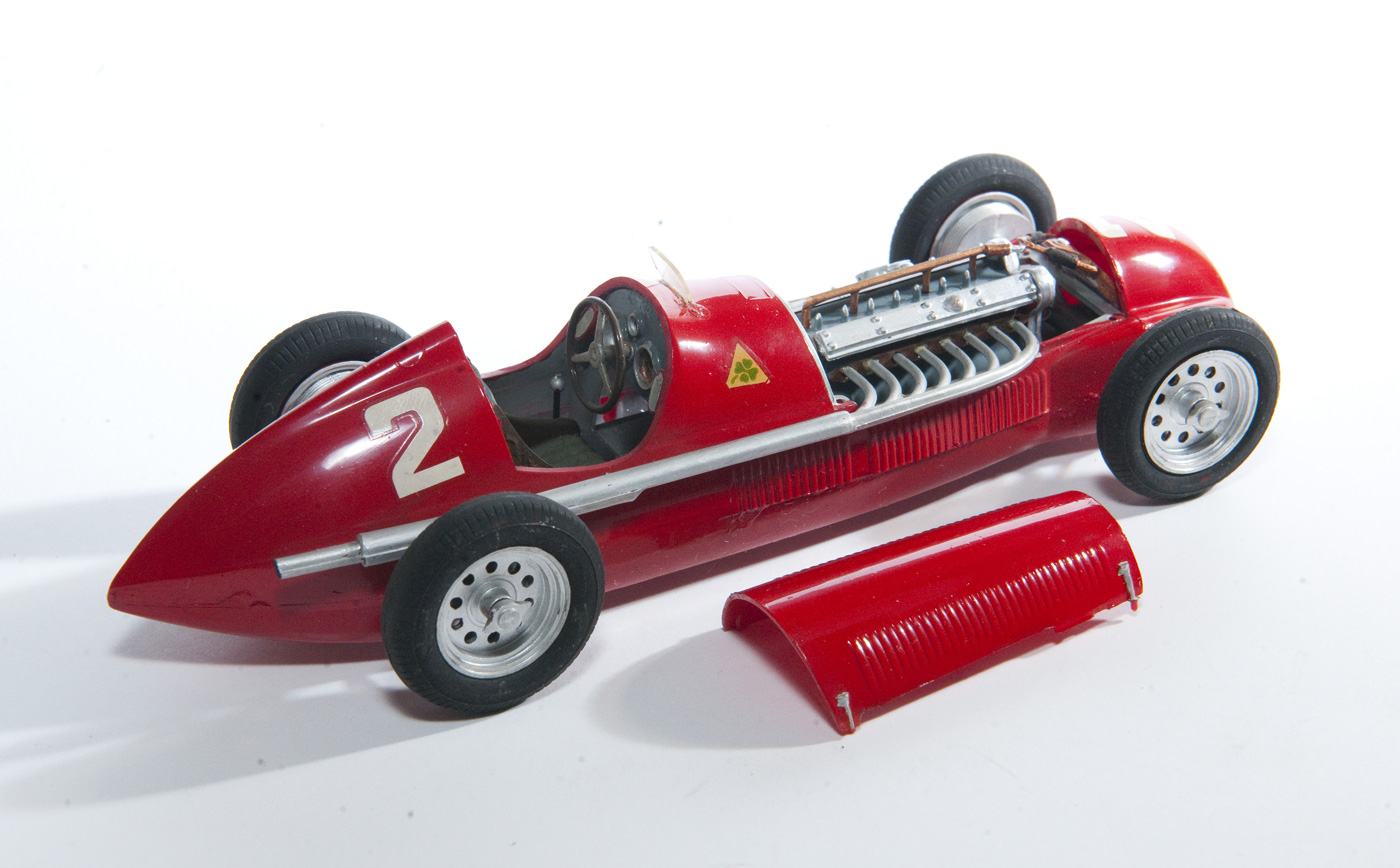
Alfa Romeo 158 with engine cover removed to show the inner details. The other “super” kit together with the Talbot-Lago.

Mercedes W 196, 1954, open wheel version. Decals are original including the chequered cover of the driver’s seat.

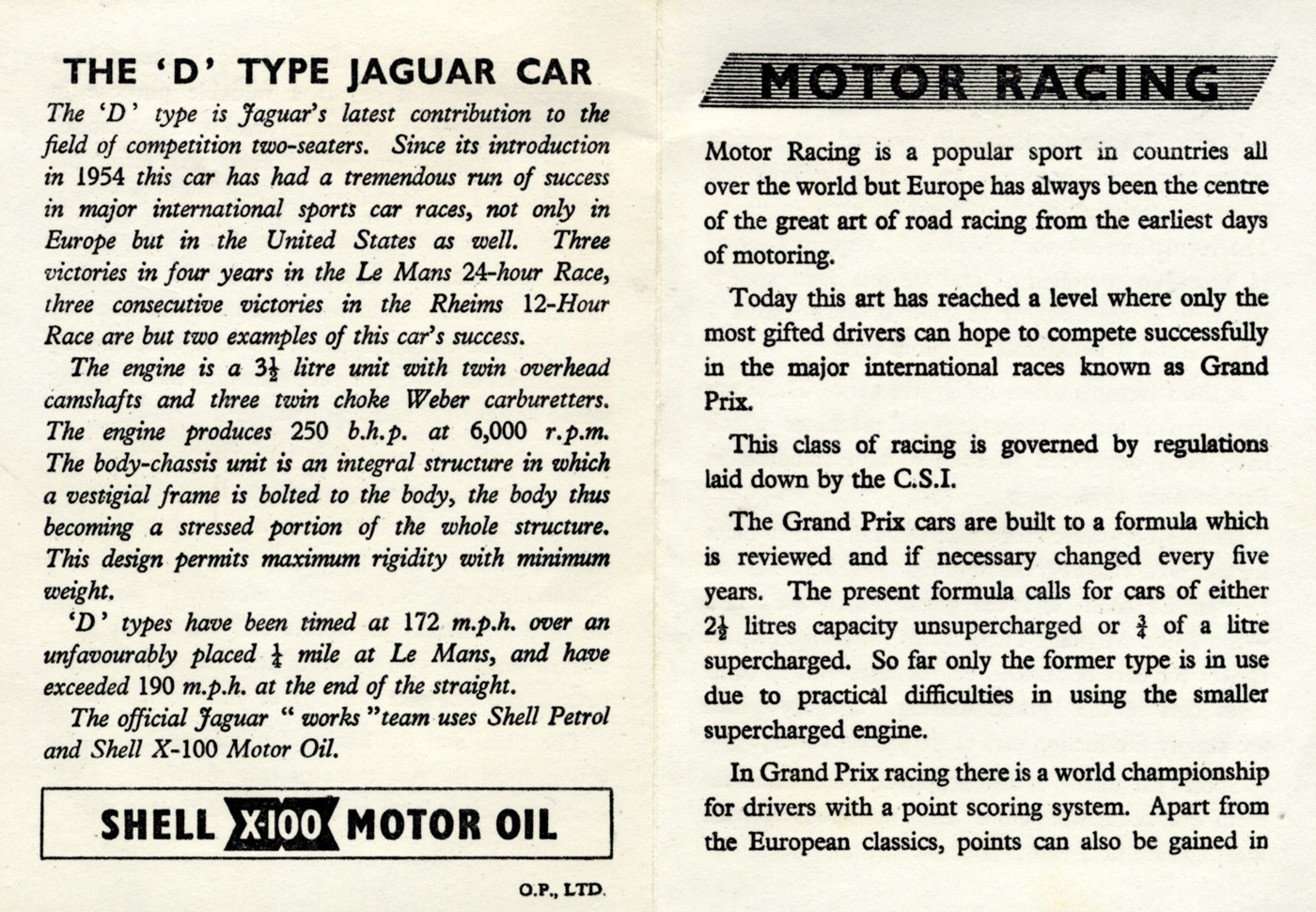
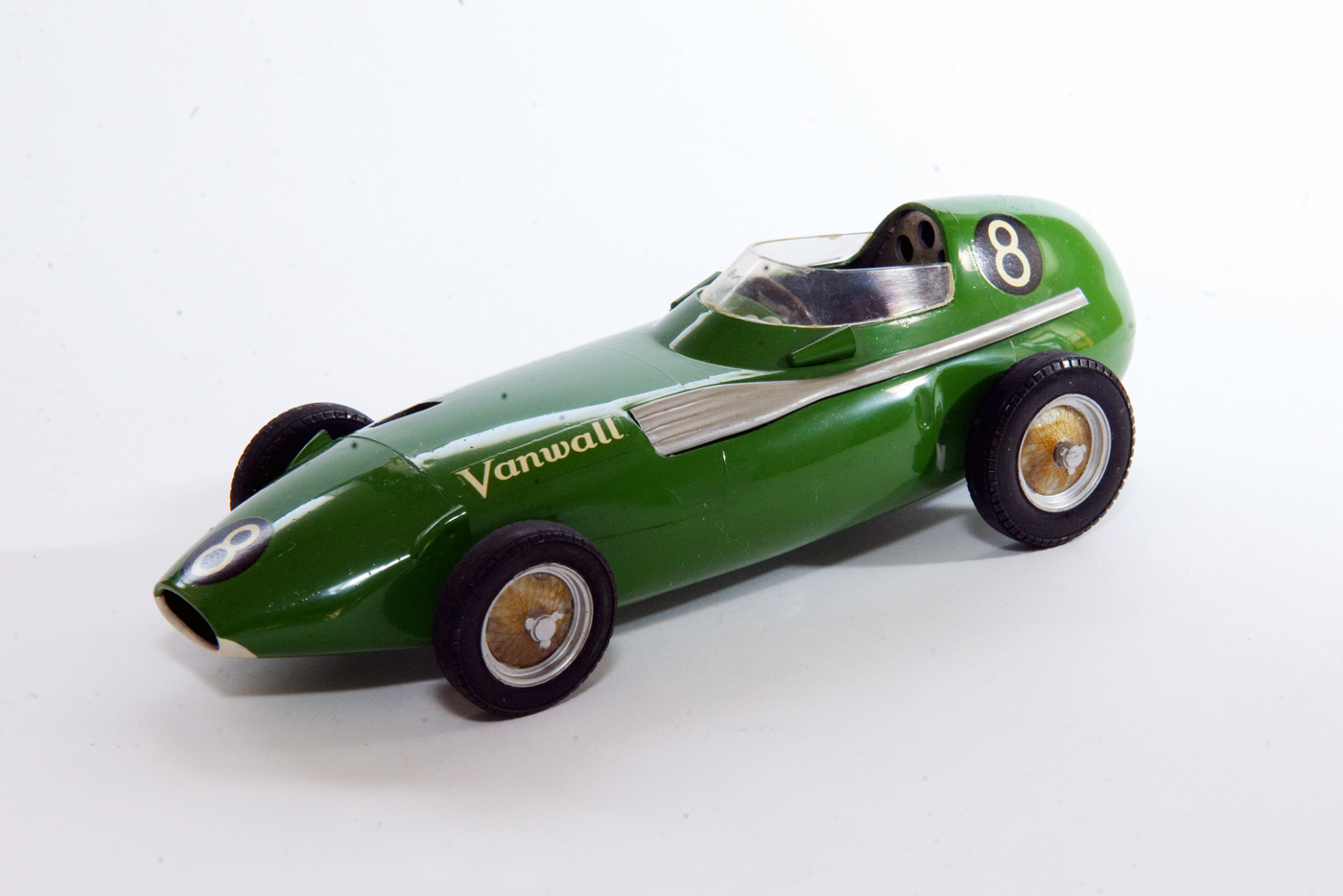
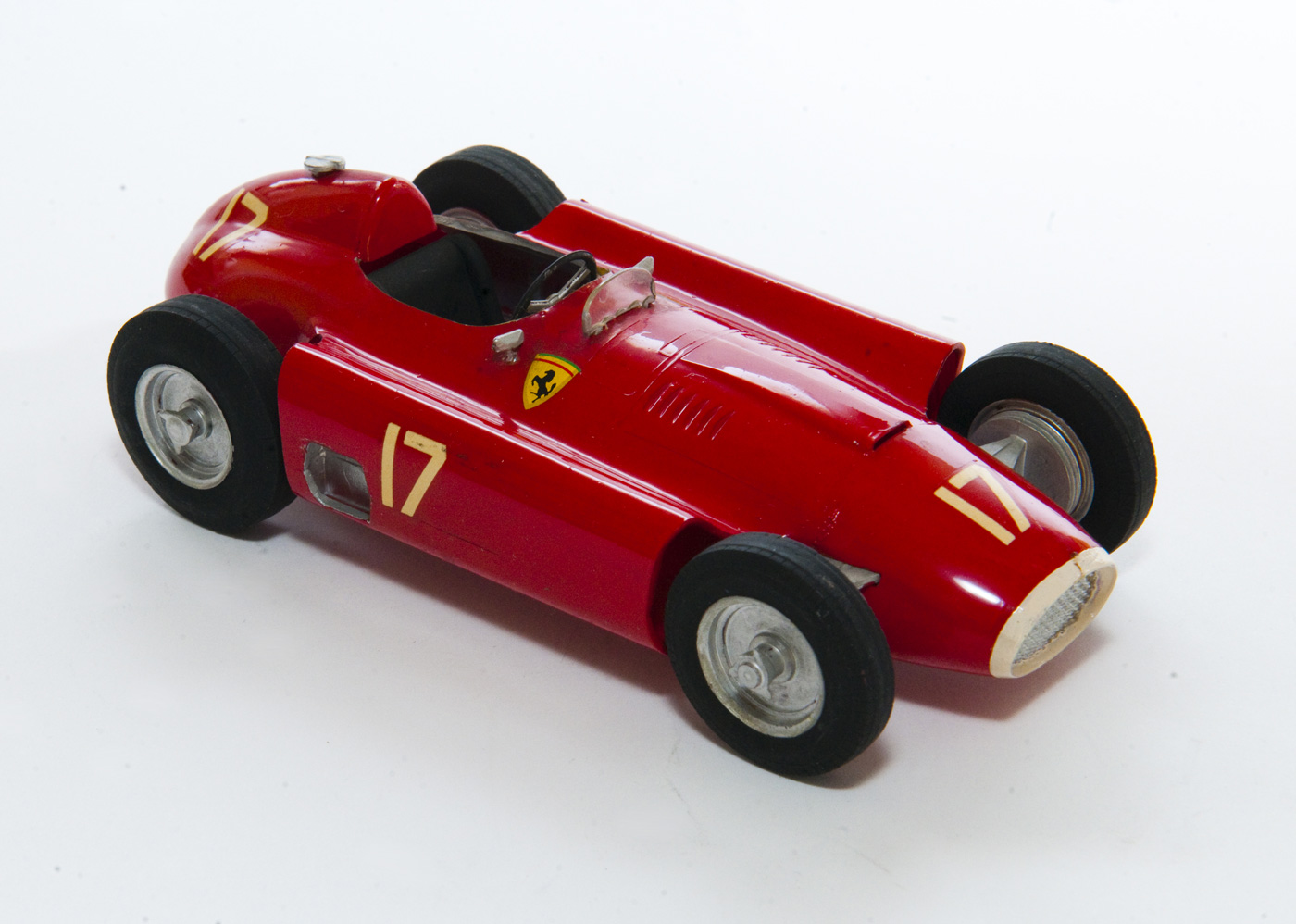
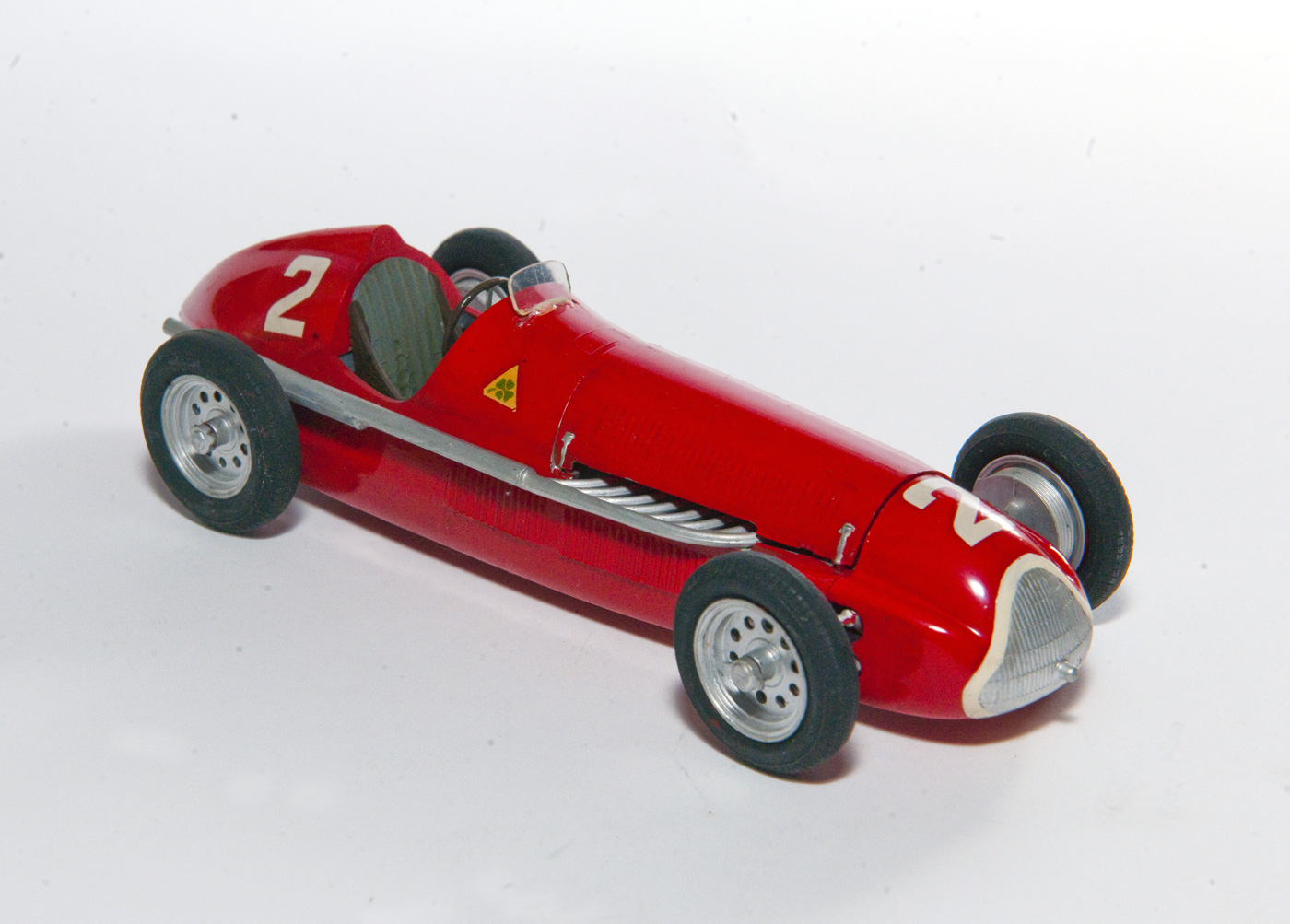
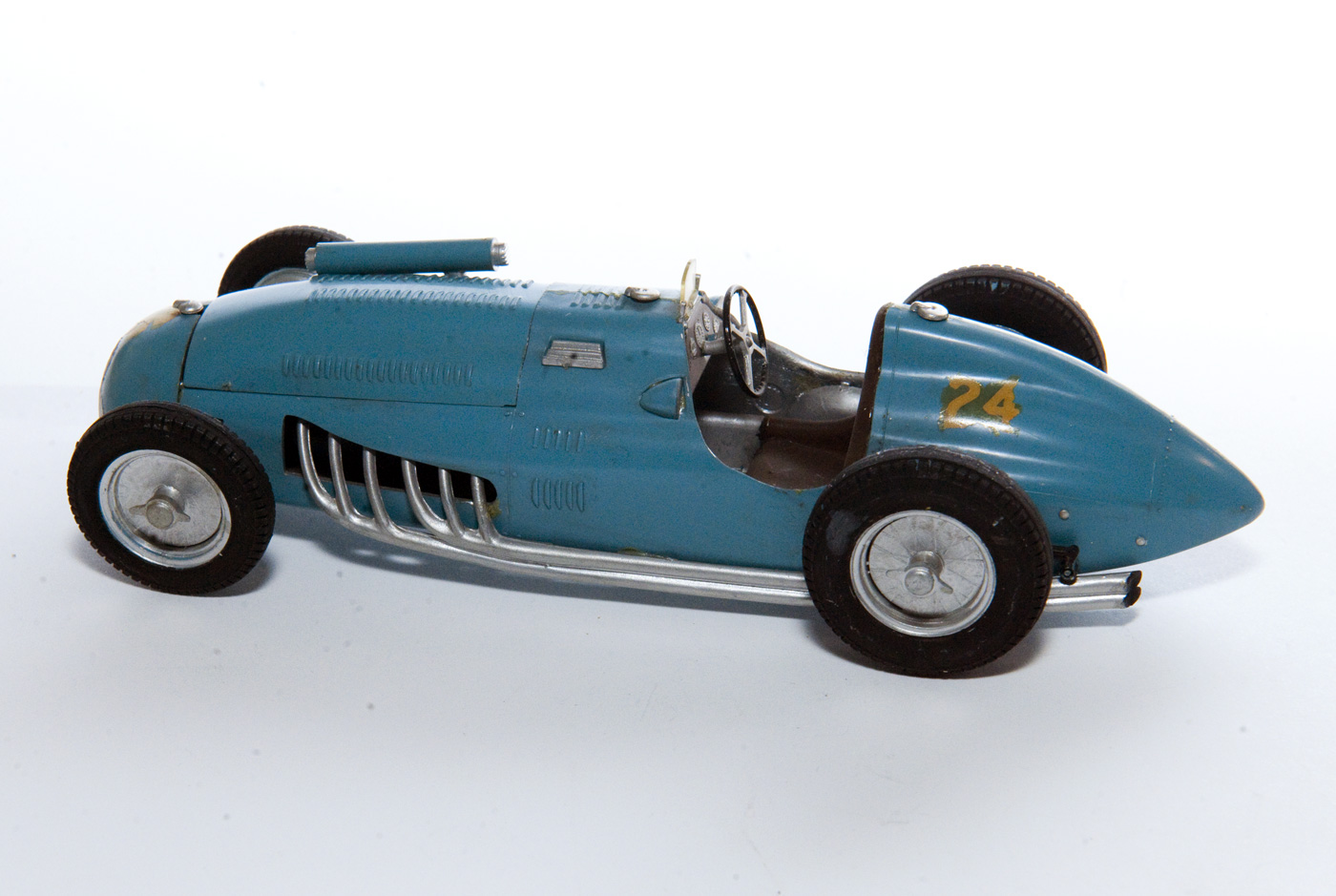
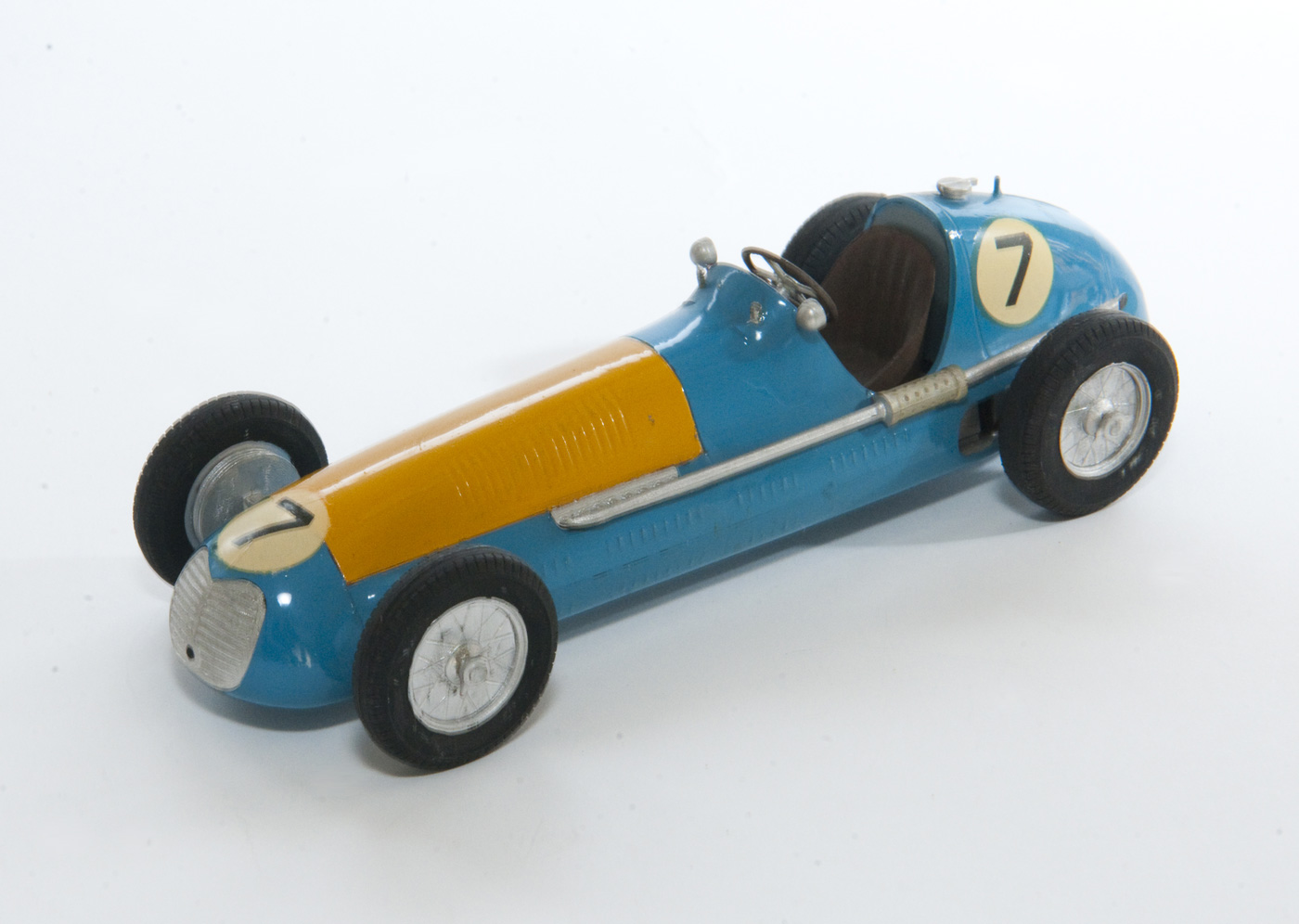
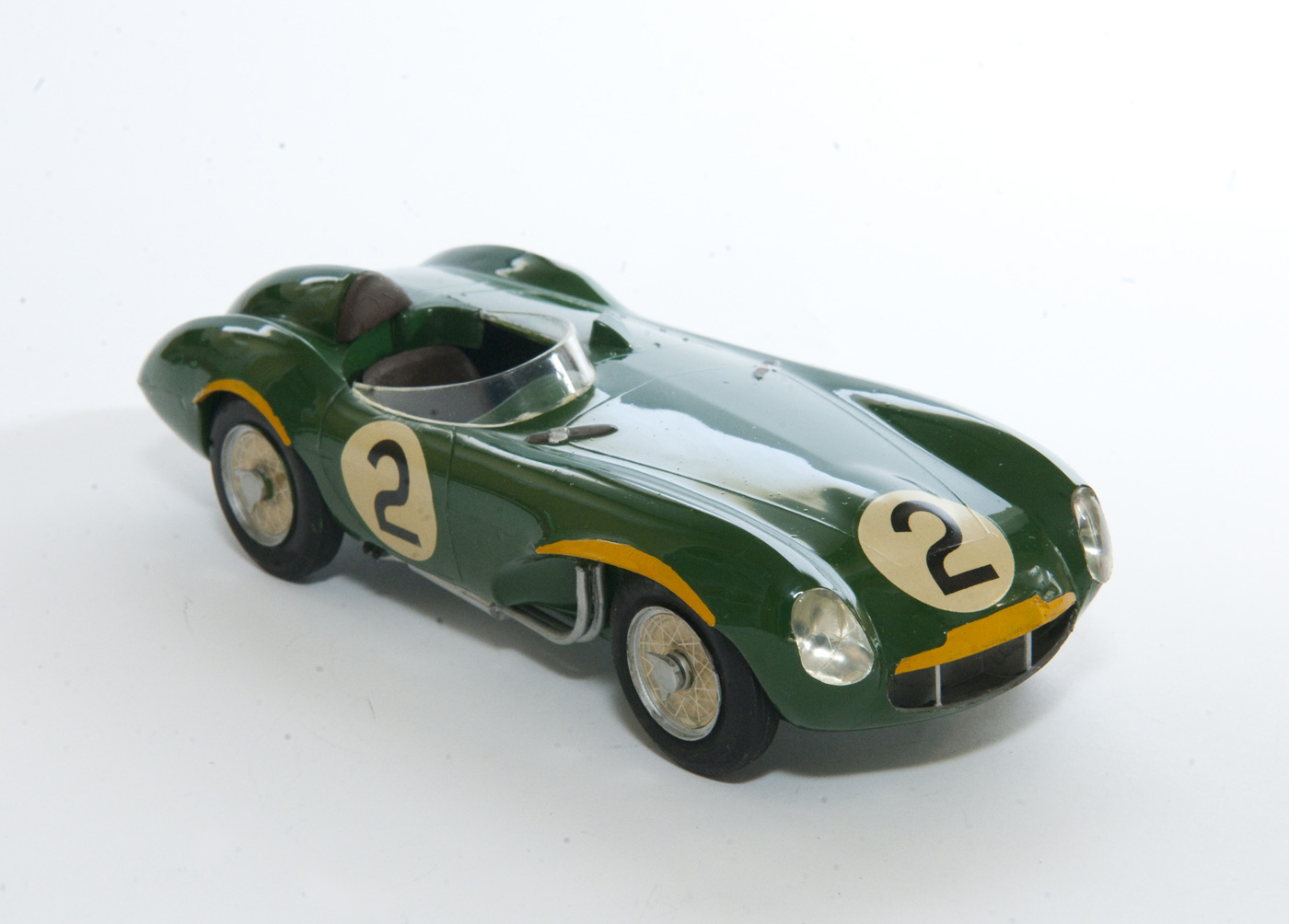
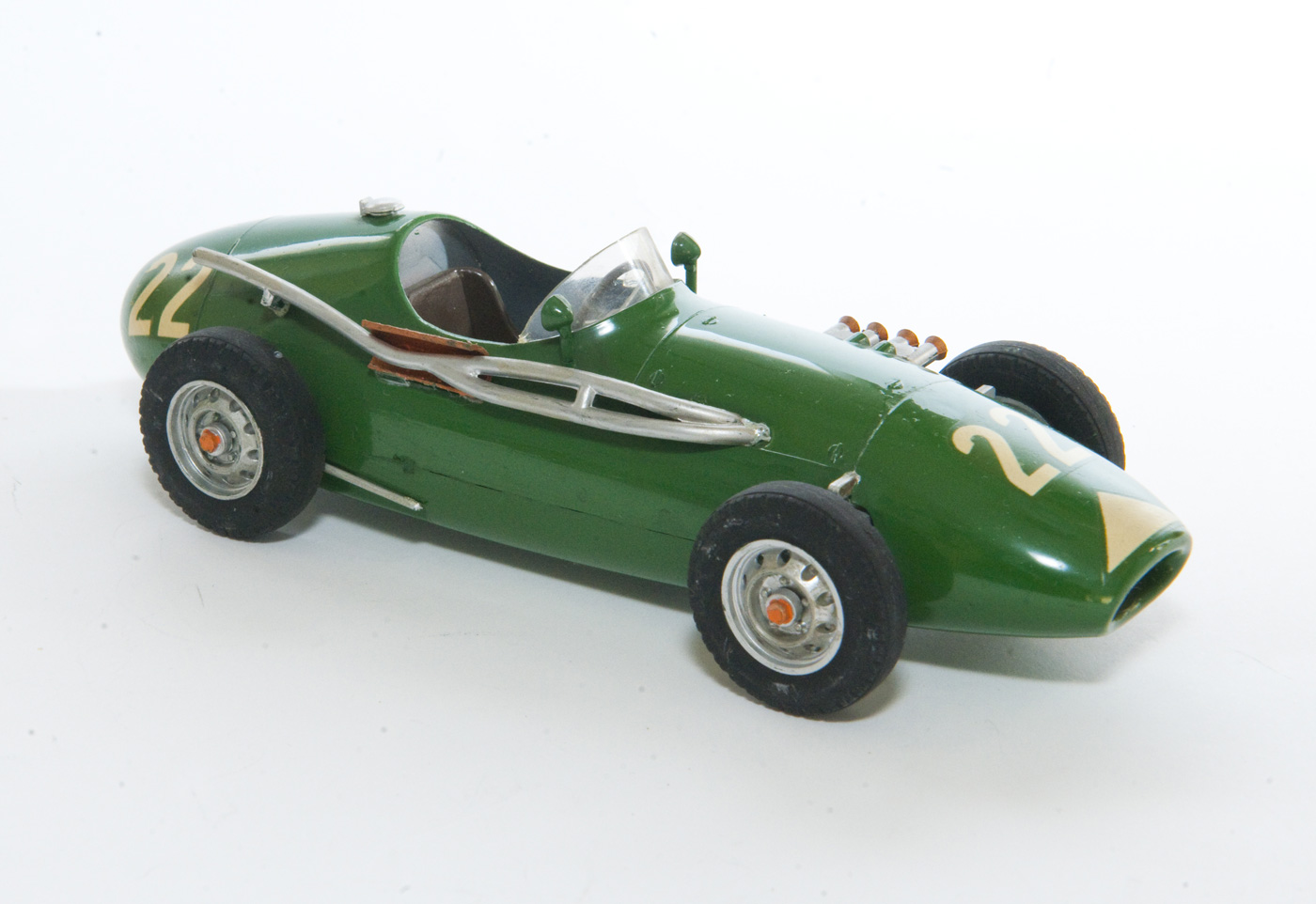
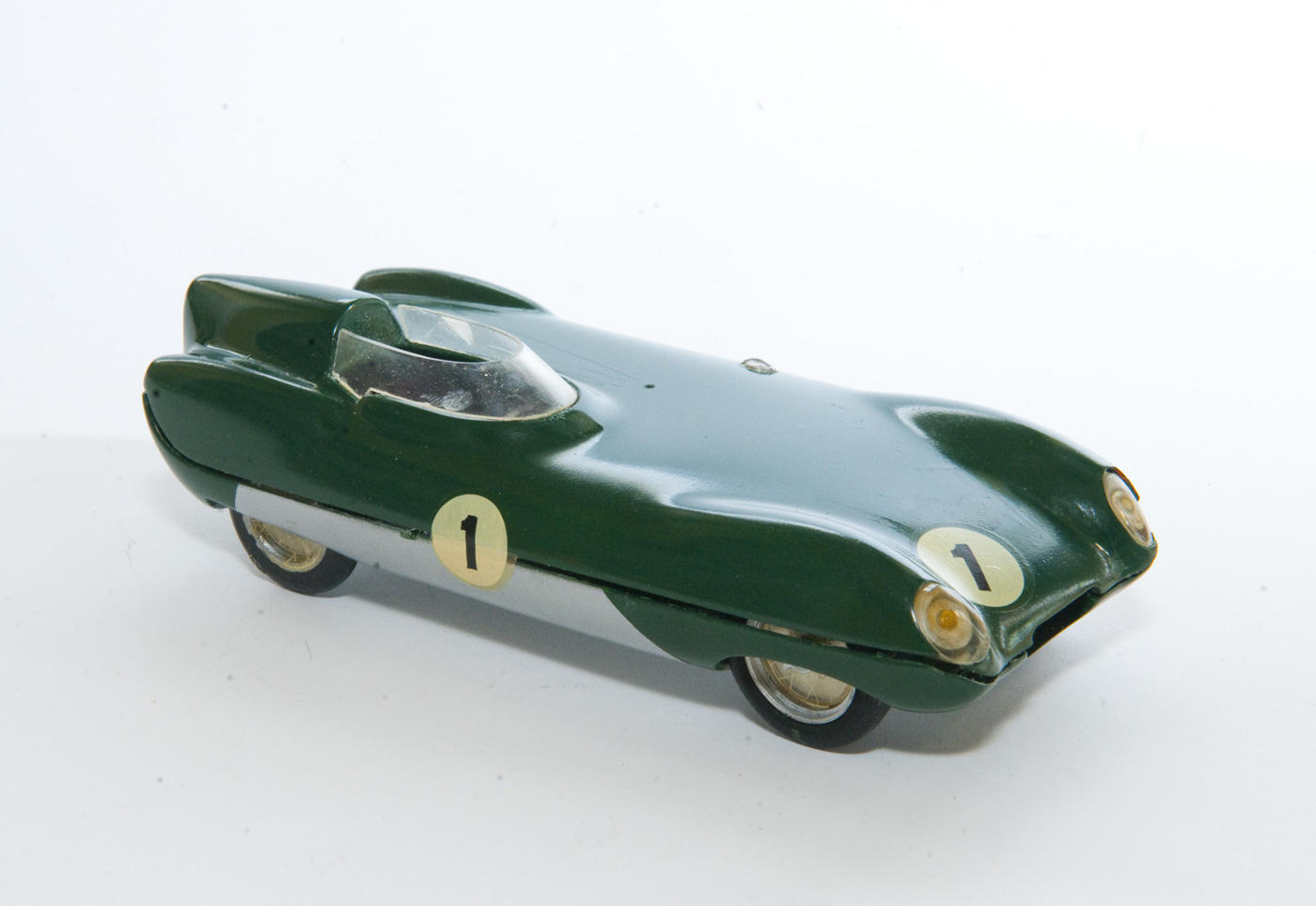
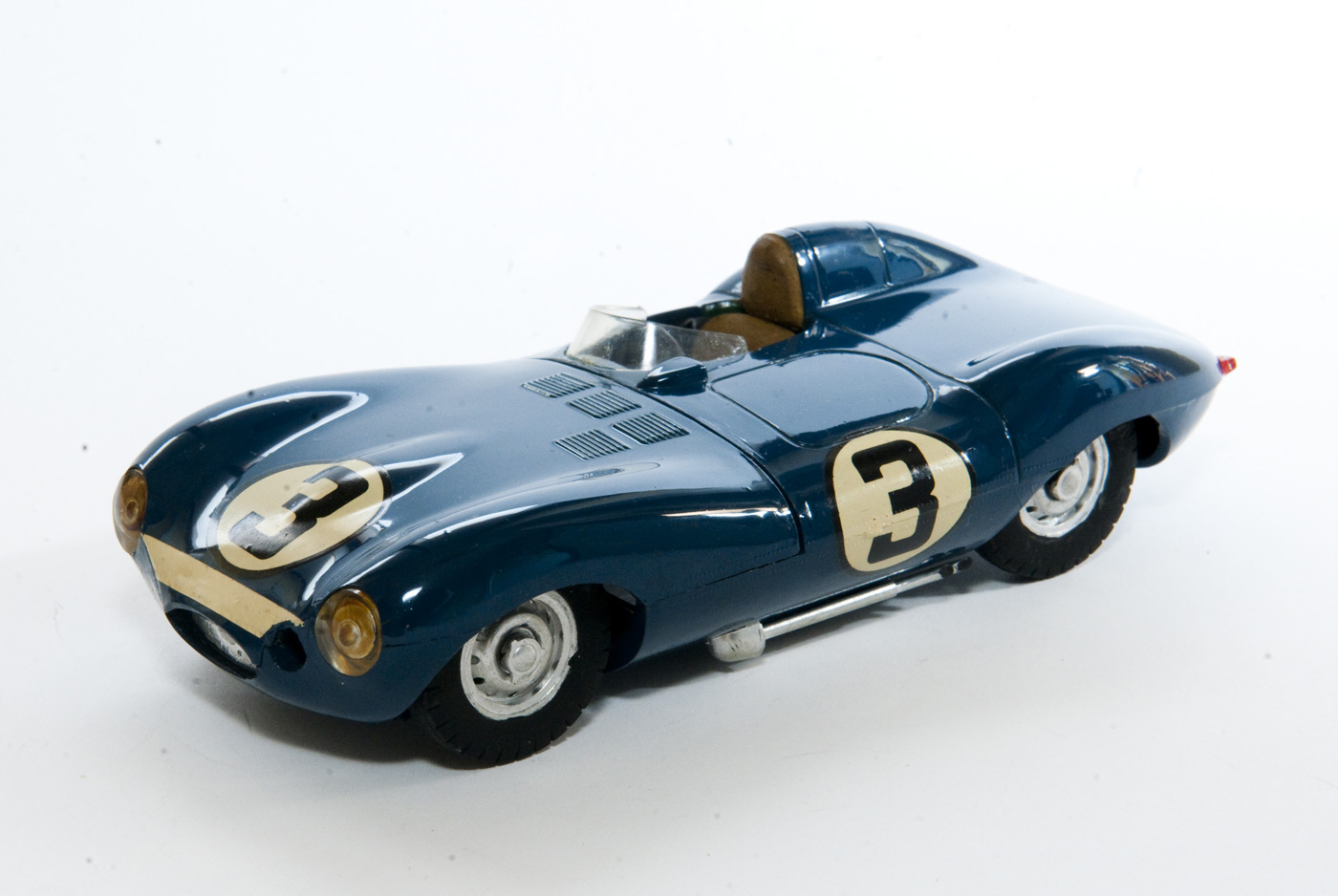
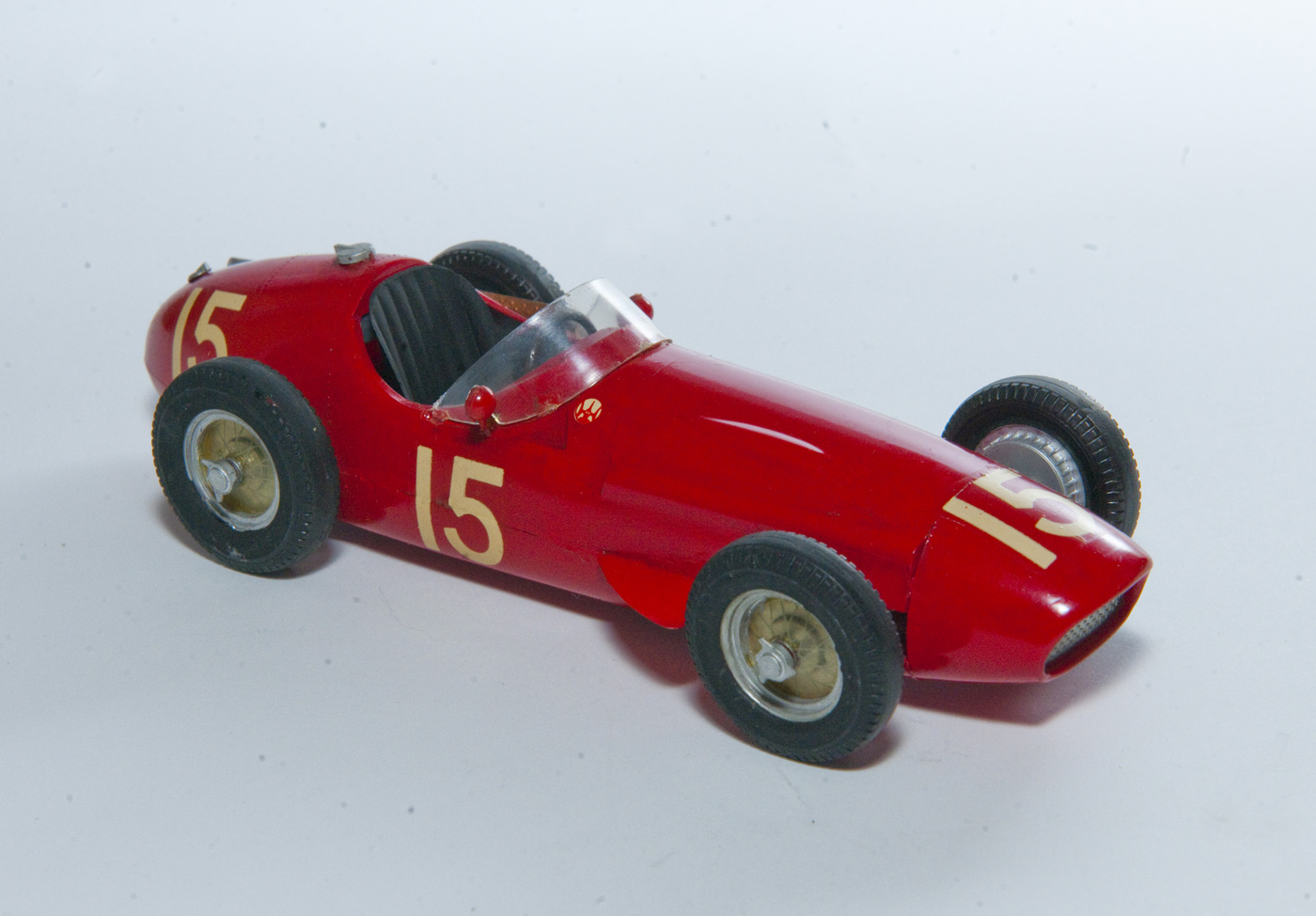

Memories, memories. What wonderful kits they were for the period.
I still have the Alfa and Talbot, in boxes and not built. Looking at them, one still marvels at the quality of the mouldings and accuracy of design. Sadly, the Cooper and Aston got built and then butchered to try and motorise them for my Scalextric – disaster! Mum finally threw them out when I started working in London.
Hi yes,
I have many of those kits!
Is there a printable story of this article?
Love to have itt
Bought several kits back then, especially the D Jaguar. Had to have that! Also had the Lotus 11 and Aston Martin DB3-S. Later Strombecker models in the US licensed the Merit kits and produced them with rubber tires. I bought and built a couple of those. Fun times!
Thanks! It rekindles great memories of building kits with my father in that period. I have often wondered if some of the Merit molds were the basis for later Strombecker kits.
I have in my collection a Merit D-Type Jaguar that was modified by a young teen ager to represent the then new Jaguar E2A. I bought it from its builder decades later as he was letting go of prized possessions later in life. Marked with the patina of time it’s not perfect, but it always brings me joy to hold and look at. It can be seen on my collection Web site.
beautyful! Lucky me I just receive an brand new original POCHER ,of an Alfetta racing
I will have great fun assembling it, my friend former Alfa Roméo Service director in Arese, had this kit & never assembled it!!
I already had done an Alfa Pocher kit at the beginning!!
assembling the wire wheels spokes with twizzers..
Here in the USA they were not available at the local hobby shops. They were sold by mail, advertised in the back of various sports car magazines by Gordon’s Book Store in New York City. We lived 17 miles to the west, so a family trip was arranged early on. My father refused to buy the Lotus, he called it too ugly. I was age 6 and loved it. He eventually bought and built all of the others, and I acquired a built Lotus about 30 years ago. Some have not aged well, but I still have them all.
I may have missed it in the article and comments but there was no mention of the “capsule” of glue included with each kit. One had to snip off the end to obtain glue. It wasn’t clear how to seal the capsule if you paused in the assembly. I’m keeping several of them unassembled not for their future value but for the. Pleasure of opening the box and enjoying the feeling of the potential lying there.
My Dad was hired by Merit to build all of their whole range of 1/24 scale racing cars and 1/48 scale planes so that they could be used for promotion purposes. I still have all of his planes that he built in addition for himself. He had a technique for duplicating bare aluminium and did all of the wire rigging where appropriate.
More recently, I have collected all of the F1 racing cars for myself. While most of them don’t have engine detail, they are products of their time. The clear plastic wheel spokes were the main weakness in my opinion. I sometimes wonder whatever happened to the collection that my Dad built for Merit.
I still have several of the Merit kits I built when I was a young teenager and best of all they’re displayed with all their warts among other cars I’ve built and many, many diecast models. For me, they still stand out in the crowd!
A friend and I both have complete sets of the Merit race cars. I used to get them as a kid from the local hobby shop in White Rock, BC, Canada. Still bring me lots of pleasure. Some of my appropriate ones are signed on the bottom by Fangio, Moss, Pete Lovely, and Jim Russell.
The Merit Kits were a revelation at the time.
As a Grand Prix racing fan, after my Dad took me to Silverstone in 1949 at age 6, these were kits that just had to be bought.
I still have them all, plus later reproductions by Smer (?).
My favorite had to be the Cooper 500, as I drove one of these around in the 50’s.
I did not see any mention of Donald Campbells’ Bluebird racing boat which I am sure was by Merit, certainly same quality and finish.
Merit plastic model kits were a breath of fresh air for their time. Who else made European racing cars in kit form? Certainly not Revell or AMT. I have all the Merit cars mostly unbuilt, and hope to have them finished before I depart this planet. There is a companion book written by that great model car collector/author Cecil Gibson. It’s called ‘Plastic Model Cars’ and it’s entirely devoted to how to detail up the Merit car kits. Although published many years ago it can still be found in various internet places and is worth seeking out. Merit kits are a wonderful memory of a great era in plastic modelling.